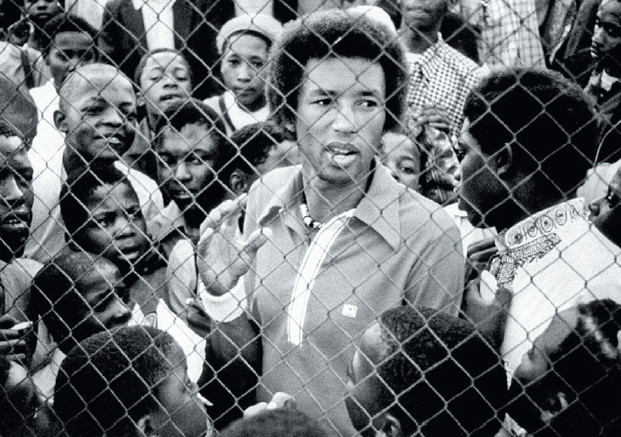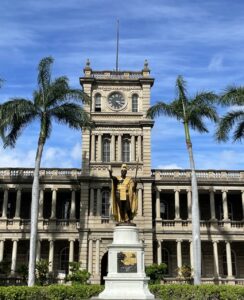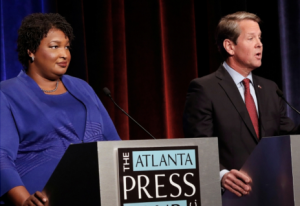In the summer of 1943, one of the greatest tennis players in the world was born. His name was Arthur Ashe, and he didn’t know it at the time, but he would grow up to make history. In 1968, at the age of twenty-five, Ashe became the first African-American man to win the US Open. He began dominating the sport of tennis and furthered his success by winning three Grand Slam titles. However, his greatest and most difficult match didn’t take place on the court at all, but rather in South Africa during the seventies.
Life for an African American was difficult enough in the United States, particularly because of the racial segregation of the time. At a young age, Arthur Ashe experienced the effects of racism in his hometown of Richmond, Virginia; he found the discrimination to be something that was part of his everyday life, and he didn’t give much thought to it. As he grew older, Ashe’s encounters with racial discrimination continued to grow. A particular incident during his freshman year at UCLA left Ashe to make a choice that would not only affect him but also his UCLA tennis teammates. UCLA tennis coach, J.D. Morgan, had a meeting with Ashe to explain the issue at hand. The UCLA tennis team had been invited to participate in a weekend tennis tournament at the Balboa Bay Club, located on the California Riviera; however, this club was deemed a “white only” club, and it prohibited African Americans from being part of this exclusive club. Morgan explained that when the invitation had arrived, Ashe was specifically left off the list in order to avoid ruffling feathers. At that point, Ashe was presented with an choice by his coach: “either the team would travel to Balboa without him or they would boycott the tournament and ‘make an issue’ of the exclusion.”1 Ashe’s final decision was to let the team go on to play in the tournament without him. He felt that by participating in a boycott, he would be placing his fellow teammates in an awkward position, which was something he did not want to do. In that moment, Arthur Ashe realized that fighting for what he believed in as well as playing the sport he loved the most would not be as simple as it seemed, and he would encounter the same issue a few years later.2

Ashe tried his best to find a balance between tennis and politics, and it was no easy task. Following his groundbreaking 1968 win at the US Open, Ashe began getting questions about racism in general, and about South African apartheid in particular. The term apartheid means “separateness” in the Afrikaan language. Apartheid refers to the notorious South African system of “rigid racial segregation, through which the ruling Afrikaner-based National Party (NP) attempted to create separate cultural, political, and social spaces for white, African, Indian, and colored (mixed race) South Africans.”3 At the time, Ashe was a quiet man, known for trying to stay out of conflict. He tried to be as clear as possible with his statements regarding apartheid so that there would be no speculation on his political views. However, his statements would come back to haunt him during an important and crucial time.4 Not long after his interview, Arthur Ashe became one of the leading voices against the harsh apartheid policy in South Africa. His firsthand encounter with the South African government took place when he applied for a travel visa so that he could participate in the 1970 South African Open. A fellow tennis player, Cliff Drysdale, who was from South Africa, warned Ashe about the low probability of being allowed into the country due to his race. At first, Ashe didn’t believe Drysdale, but after his application was rejected not once but twice, Arthur Ashe began to see the issue at hand.5

The strict apartheid policy in South Africa was put into effect in the late forties and early fifties. The major objective of the apartheid system was “to prepare, to program, and to destine young blacks…for a lifetime of servitude.”6 As mentioned previously, Ashe had spoken out against the apartheid policy in South Africa at the time. Learning about Ashe’s increasing activism and anti-apartheid statements, the South African government claimed that his actions provided cause for the prime minister to deny his request for a visa. In 1969, Arthur Ashe, along with other African-American athletes, were placed on a list of individuals who had been barred, or prevented from entering, South Africa. In the wake of being barred, Ashe took this opportunity to speak up and use his status as a professional athlete to argue for some form of punishment towards South Africa for its racial practice of apartheid. Ashe tried to convince his fellow teammates, who were all white, to protest alongside him, but many expressed little or no interest to assist Ashe in his fight for change. A majority of people thought that Ashe’s decision to fight to play tennis in South Africa was not a good idea from the start. In addition to this, racial activists in the United States were angered at how Ashe had his attention focused solely on the discrimination in South Africa and not on the discrimination his fellow black men and women were facing back home. Ashe had his own personal reasons for becoming an anti-apartheid activist. He viewed the actions of South Africa as an offense directly to himself and to his career. Ashe saw this situation as a way to speak up for those who couldn’t, and one way he did so was by participating in several protests, some occurring in Washington D.C. Ashe viewed his participation in these protests as his direct contribution to the citizens of South Africa, hoping that it would create a path for equality.7
About four years after Ashe’s head-to-head match began with the South African government, he was ultimately granted a visa in 1973. Before he agreed to play in the South African Open, Ashe made a special request. He specifically asked for the attending crowd to be seated in an unsegregated fashion; his request was granted. The day of November 26, 1973 was one of the most significant moments in Arthur Ashe’s life; feeling the pressure to perform his absolute best, Ashe managed to make it all the way to the finals, in which he played against fellow American tennis player, Jimmy Connors. Although Ashe did not win the match, many of South Africa’s citizens, specifically the young black boys, looked at him with great respect and awe.8 However, Ashe’s tennis playing in South Africa was not finished just yet; the following day after losing to Jimmy Connors, he and Dutch tennis player Tom Okker played together to win the doubles championship of the South African Open.9

While Arthur Ashe continued to be a voice for the anti-apartheid activists, he was still training and winning tennis championships. Prior to playing in the South African Open in 1973, Ashe participated in the Australian Open on January 26, 1970; he went head-to-head with Australian tennis player Robert “Dick” Crealy in a match that was struck by bad weather. The wrath of Mother Nature proved to be no problem to Ashe,as he went on to defeat Crealy in two straight sets, making this his second Grand Slam title win. In 1975, Ashe met defending champion Jimmy Connors on the tennis court for a second time, when both men battled for the Wimbledon Grand Slam title. At one point, it seemed that Connors would definitely take home the title but Ashe stopped that real quick. After breaking Connors’ serve two times, he had finally done it: Arthur Ashe won his third Grand Slam title as well as becoming the first African-American man to win the singles title at Wimbledon.10. Arthur Ashe had several major accomplishments in the tennis world that created a long-lasting legacy for him and that’s what he is most often regarded for. However, his perseverance in his four-year head-to-head match with the South African government is an aspect of Ashe’s life that is often overlooked, but not anymore.
- Eric A. Hurt, Arthur Ashe: Tennis and Justice in the Civil Rights Era (Baltimore: John Hopkins University Press, 2014), 8. ↵
- Eric A. Hurt, Arthur Ashe: Tennis and Justice in the Civil Rights Era (Baltimore: John Hopkins University Press, 2014), 47-48. ↵
- Edward Ramsamy, Andrea L. Santon, Peter J. Seybolt, “Apartheid,” Cultural Sociology of the Middle East, Asia, and Africa (Thousand Oaks: Sage Publications, 2012), https://search.credoreference.com/content/topic/apartheid?institutionId=4592. ↵
- Eric A. Hurt, Arthur Ashe: Tennis and Justice in the Civil Rights Era (Baltimore: John Hopkins University Press, 2014), 65. ↵
- Arthur Ashe and Arnold Rampersad, Days of Grace (New York: Knopf, 1993), 104. ↵
- Allen McDuffee, “When Arthur Ashe fought to play tennis in apartheid South Africa, he faced bitter criticism,” Timeline, September 29, 2017, accessed September 8, 2017, https://timeline.com/arthur-ashe-south-africa-99c415a6aee2. ↵
- Eric A. Hurt, Arthur Ashe: Tennis and Justice in the Civil Rights Era (Baltimore: John Hopkins University Press, 2014), 98. ↵
- Allen McDuffee, “When Arthur Ashe fought to play tennis in apartheid South Africa, he faced bitter criticism,” Timeline, September 29, 2017, accessed September 8, 2017, https://timeline.com/arthur-ashe-south-africa-99c415a6aee2. ↵
- Eric A. Hurt, Arthur Ashe: Tennis and Justice in the Civil Rights Era (Baltimore: John Hopkins University Press, 2014), 175. ↵
- Eric A. Hurt, Arthur Ashe: Tennis and Justice in the Civil Rights Era (Baltimore: John Hopkins University Press, 2014), 126, 214. ↵



42 comments
Jake Faryniarz
This is a very interesting article about Arthur Ashe. Since he was the first African American tennis professional he changed the way tennis was perceived. During that time he faced a lot of backlash for being black and he had to fight through the struggle and fight against racism in tennis. Since he was such a great athlete he was able to show that any race can win a major tournament in tennis which helped inspired many people to follow in his footsteps. This was a great article and it shows how Arthur Ashe was able to leave a legacy on tennis and his push to fight racism.
Nicolas Llosa
This is a really well-written article. It describes how tennis changed Arthur Ashe and how he changed tennis. He faced many challenges throughout his career but he still stood out in the tennis world. His perseverance to fight against racism in tennis really set an excellent example for society as a whole. The way he was able to keep winning major tournaments and fighting against racial segregation at the same time shows his strength, discipline, and courage. Overall, I think this article was very interesting and showed a different side of Arthur Ashe’s life and how he also took his proactive stance against racism to tennis.
Bailey Godwin
Arthur Ashe has always been a legend/ figure I have heard of because I have played tennis for most of my life. I never knew what great voice he had in standing up for racial segregation to his own country. I love how he used his platform and what he had worked so hard for to help not only himself, but others as well.
Emmanuel Ewuzie
Arthur Ashe is a legend in the tennis game. My family and I are huge fans of tennis. We love to watch all of the grand slams/ majors. We also watch local tournaments as well. While watching the U.S. Open, we always hear about how marvelous Arthur Ashe stadium is. I hope we will be able to go to the U.S. Open one day.
Jose Maria Llano Aranalde
This was a really interesting article. Its always great to see athletes do use there fame for something greater. I also liked how he grew into his role. He wasn’t as outspoken at first. He had the same ideas and views on the topic but didn’t speak on it until later. He was one of the best tennis players but I think this elevated his stature. Even to this day I think the things he did outside the tennis court made a bigger impact than the things he did on the court.
Alexander Avina
This was a very enjoyable article. I can truly say that I learned something new and interesting. I am glad that I stumbled upon this article. It was a very informative article for a casual tennis fan. Arthur Ashe was truly a pioneer for African American tennis players and he paved the way for so many young people. It was a very good-spirited and fun story to read.
Kelsey Sanchez
This article was quite interesting due to the fact I have never had heard of this tennis player. I was surprised by how Arthur was shy but later confronted with what he wanted to do. It was probably not easy for him, but I am glad he was able to stand up for himself and do what he loves the most. For him to be able to be the first African American to win the singles title at Wimbledon was the outstanding part in this article. I liked how well the shyness and confrontation came to be throughout the article.
Sydney Hardeman
This was a great article. Arthur Ashe is a legend and although I knew about him being the first black man to win a title at the US open and Wimbledon, I did not know all that he went through as far as the Apartheid going on in South Africa. I knew about some of the racism he endured in the United States obviously, but it was interesting learning about the rest of his story.
Charli Delmonico
This article was amazing! I play tennis competitively and whenever we are asked by coaches who we respect the most in the game of tennis, Arthur Ashe’s name is always mentioned. I think it is so cool that he was able to make such a big difference in society by using his platform of being an exceptional athlete. To think that he was able to make such an impact while training and playing constantly is incredible. He is respected for both his tennis abilities and his push to end apartheid in South Africa while also fighting against racism in his own country.
Emily Velazquez
I had never heard of this tennis player or activist before. However, this was a very interesting story. The sport is what changed him. He was at first too shy to do anything about his rights but eventually he grew as a person and found that he needed to stand up for himself. It is amazing how influential he became, not only standing up for himself but standing up for others by being a voice for the anti-apartheid activists.